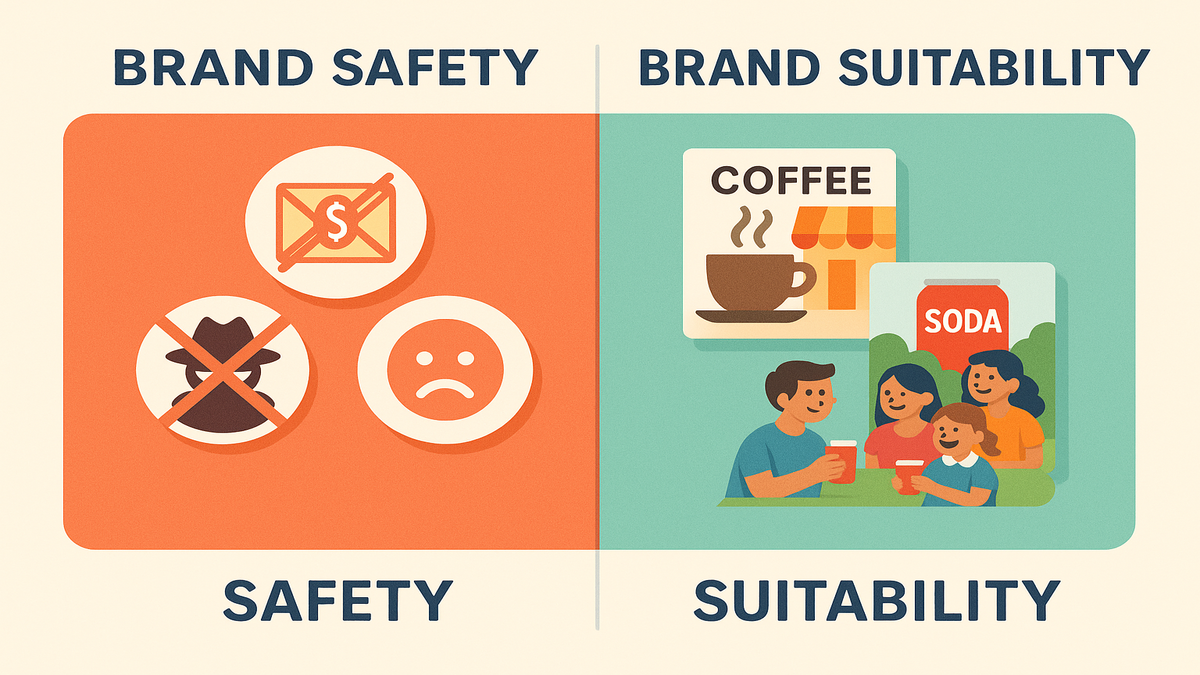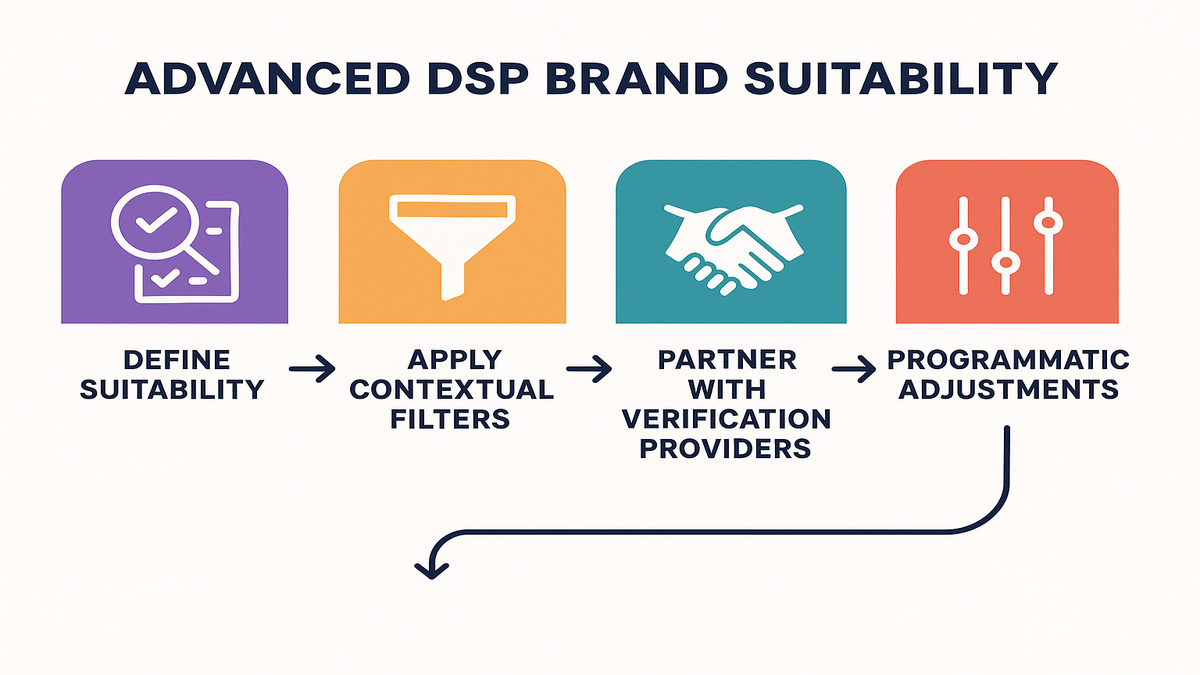
Unlocking DSP Brand Suitability: Smarter Ad Placements Now

Advertising used to be like rolling dice. Think about this: you build a killer campaign for your eco-friendly coffee. Then it shows up before a wild hunting tutorial or stuck between a crime doc and bad news blips.
The crowd you reach? At best, scratching their heads. At worst, outright confused. Not a recipe for instant brand fans.
That’s old-school. Today’s digital marketing world? Way different. Where your ads show up matters more than ever. Just avoiding fraud sites and scandal isn’t enough. The new gold standard? Not just brand safety (dodging harm), but brand suitability (making ads click in the right place). This difference? Could be what gets you noticed… or leaves your brand as social media roast material.
Big twist coming for 2024: now, with DSP (Demand-Side Platform) open betas from big names like Adobe and Amazon, advertisers can dial in exactly where and how ads appear. Not just dodging disasters, but picking the perfect vibe, every time. No more blowing cash on the wrong crowd or ending up in meme fails for zany ad placements.
What’s behind all this? Fancy new suitability settings, serious API power, and a data-first game plan built with the world’s sharpest ad checkers. Want your brand to be the main character, not the flop? Stick around and see how you outsmart old-school tactics and run DSP campaigns that are spot-on and squeaky clean. (If you want to crank up your Amazon DSP results, check our DSP Services for pro tips.)
Key Takeaways:
- Brand suitability isn’t just brand safety. It’s sharper, more personal, and a must-have now.
- New DSP open betas (Adobe, Amazon) let you adjust suitability for each advertiser and ad group.
- Partnering with big name tech keeps your ads safe from scams and bad spots.
- APIs and third-party tools make targeting and reports smarter than ever.
- Twitch is paving the way, but more options are coming fast.

Don’t Just Dodge Mistakes—Own Your Ad Spots
Brand Safety vs. Suitability
Let’s break this down. Brand safety is like having a tough bouncer at your club door. He keeps out anything sketchy, scammy, or gross that could hurt your brand. It’s either safe or not. Simple, but not clever.
Brand suitability is more like having your own personal stylist and hype crew. It makes sure your ad matches the mood, the people, and the moment. Not just “not-bad”—but actually fits. Like, would you really want your silly snack ad stuck between dark crime shows? Probably not. That kind of mismatch kills engagement and could make you the joke.
With so many channels and content types out there, where your ad lands totally shapes how folks remember you—or if they care at all. Mess it up, and folks won’t just ignore you—they’ll remember you wrong. In a 2023 study, more than 70% said ad context shapes what they think about the brand (IAS 2023 Industry Pulse). Ignore that and you risk big trouble.
“Safety is binary; suitability is a spectrum. Custom fit always beats off-the-rack.” — Ad industry strategist, 2024
Open Beta Suitability Settings
Campaign Customization
Let’s talk nuts and bolts. These new DSP betas, mainly Adobe and Amazon, let you set suitability at lots of levels:
- Advertiser-Level: Pick a fit that works most of the time for all your ads. Think of it like rules for your whole brand. Wide lanes—it keeps stuff from going too crazy.
- Ad-Group Level: Want more control? Set up for each campaign. Maybe your Gen Z meme campaign needs gaming streams and silly channels, while your classy rebrand sticks to serious news or top lifestyle sites.
- Real-Time Tweaks: If your crowd or the web switches gears, change your settings fast using APIs. No waiting months to fix goofs.
Adobe DSP, for example, lets you plug suitability right into your campaign goals with special tags (like “ADSP_”), and you can tell the system what matters most (“newsworthy AND family-friendly,” for example). It’s like getting to tweak your strategy without waiting for approval from some far-away boss.
Filters and Segments
With these betas, you get plug-and-play connections to checking tools like DoubleVerify, IAS, and Peer39. Here’s what this means:
- Block What Bugs You: Set filters to skip not just obvious bad stuff, but even genres or sites that just aren’t your thing.
- Granular Tags: Mark and organize where your ads land using partners like Comscore or Peer39. Aim for spots that feel just right.
- First-Party + Pre-Bid: Take Amazon’s own deep data plus instant blocklists, so risky pages never see your ad. See a flag? You just saved money and reputation.
- Sentiment & Topic Filtering: Use smart tools to watch for bad moods or topics in content so you skip awkward combos (like a cheerful ad in the middle of crisis news).
The Tech Stack
Control by Placement
Automation’s a big deal now. New APIs let you control your creative assets, budget, and ad spots all at once. Imagine uploading tons of ads, and with API calls, sending each to just the right spots. No more endless dashboard clicking. Boost spend on the spots that work, and cut back on duds, all in real time.
New Integrations
How are top DSPs building this in for you?
- DoubleVerify Integration: Segments help dodge the wrong content or bad sites by default.
- Oracle Data Cloud: Brings in news about the context, mood, and shift in risk. You see more than just “is it safe?”
- Synced Reports: Everything you do shows up in dashboards. You’ll know fast what’s working, what’s not, and what needs tweaking. Less digging for stats, more acting on them.
A Sample Flow:
- Set
brandSafetyTierTargetAPI per ad group. - Block crime, adult, or negative stuff via your partner’s tools.
- Use DoubleVerify or Peer39 segment IDs to skip over junk or weird sites.
- Watch your suitability dashboard for alerts and adjust quick if needed.
Industry Teamwork
No one keeps ad space safe alone. That’s why most DSPs are teaming up with:
- IAB (Interactive Advertising Bureau): Laying down the law so “safe” means the same everywhere.
- TAG (Trust and Accountability Group): Setting what counts as real, clear verification.
- WhiteOps, MOAT, Pixalate: Catching bots, checking for real views, and stopping scams so your money gets real eyes—never fake clicks.
- Nonstop Inventory Audits: Regular sweeps look for honey pots and scams, ditching junk inventory and keeping brands safe.
It’s like a bouncer, a watchdog, and a camera crew guarding your ad cash all day, every day.
Amazon DSP’s Open Beta
Here’s a real-world example people are watching: Amazon’s open beta DSP has:
- First-party and third-party checks (DoubleVerify, Oracle, Pixalate) working together
- Ad blocks based on keywords, page type, and where you show up on Twitch
- Pre-bid guards, so you never spend on weak placements
- Programmatic creative swaps, so you can adjust fast based on fresh suitability data
- Real-time suitability reports—you can tweak your approach even mid-campaign and save your impressions
These tools will soon go from beta to normal for all major DSPs. Smart brands are diving in now to set the pace, not play catch-up later.
Suit Up Your Plan
Define, Filter, Repeat
Time for real talk. Before you use a filter, actually define your brand’s idea of suitability. It’s different for each crowd and every campaign, so build a guide you keep updating as you learn.
- Contextual Filters: Block not just the baddies, but any mood that clashes. Some brands skip true crime; others avoid politics.
- Custom Segments: Use partners to stake out exactly what you allow—not just domains, but page topics, categories, even certain themes.
- Bid Adjustments: Raise or cut bids based on how well placements fit. Maybe spend more for busy Twitch streams when your message fits.
Pro Tip: Preview ad spots with DSP console tools before you launch. Test in small batches. When data rolls in, tweak every week (not every quarter). That way, nothing slips through the cracks.
Test, Learn, Optimize
- A/B Test Ads: Try different versions and match them with different content types. Look beyond clicks—check perception and actual boost.
- Suitability Reporting: Amazon’s Suitability dashboard shows where your ads landed, what got blocked, and how assets did. Use the data to shift your play fast.
- Measure Brand Lift: Tools like Brand Lift Study (and outside research) show you if your suit-up plan is boosting intent and brand love.
“Every brand has its own ‘do not cross’ lines. Find yours—and keep them strong everywhere you buy ads.” — Digital ad chief, Fortune 500

What’s Next?
The future? More automation, more smart moves:
- Deeper API Tools: Soon you’ll set suitability by API for all types—inventories will go way past Twitch and Display. Video, audio, even weird new formats are on the way.
- Support for More Formats: As digital stuff gets wilder (think AR, shoppable vids), suitability settings will keep up. Be ready.
- Better Reporting: You’ll tie spend not just to views and clicks, but to actual context—finally know if you showed up at the right time and place.
- Suitability Built In: Soon, suitability isn’t optional. It’ll be as normal as setting your budget. Get ahead now while others play catch-up later.
Suitability IRL: TL;DR
- Brand suitability’s about the right fit, not just dodging disasters
- DSP open betas (Adobe, Amazon) give new ways to fine-tune at every level
- Tools like DoubleVerify, Peer39, and Comscore power deep checks
- Creative Management APIs keep optimization going without you lifting a finger
- Industry squad and certified partners keep your ads reaching real folks—not bots or sketchy junk
FAQ
Q1: What’s the real difference between safety and suitability?
A1: Safety keeps you out of scary or rude spots. Suitability is deeper—it makes sure your ad feels right for your brand in every scene.
Q2: Will strict filters shrink my reach?
A2: Yep—but that’s on purpose. You’re swapping big numbers for better results and less risk. Quality tops quantity every time.
Q3: How do Amazon and Adobe DSPs keep things sharp in beta?
A3: They use instant checks (pre-bid), let you swap creative fast, and connect with top checker tools. All in near real time, so you’re never guessing.
Q4: What third-party tools help with suitability?
A4: DoubleVerify, IAS, Peer39, and Comscore all help you double-check context, track publishers, and sniff out risk.
Q5: Is Twitch the only beta for these new settings?
A5: Twitch is the main one right now for Amazon DSP. But more channels and formats are rolling out fast as they prove it works.
Q6: How do I see if it’s working?
A6: Use your DSP’s dashboards, run Brand Lift checks, and track with Amazon Attribution—these connect performance to context.
Suitability Checklist
Time to move from hope to knowing you’re covered. Here’s your start:
- Define suitability: What’s hot, what’s not for your vibe, message, and placement.
- Set targets in DSP: Use APIs at both brand and campaign levels. Build smart defaults, but allow tweaks for edge cases.
- Layer on filters: Use segment IDs, blocklists, and trusted tools to filter placements.
- Preview spots: Try preview reports and run tiny test campaigns before launch.
- Keep tweaking: Review dashboards and real numbers weekly. Change filters, swap assets, adjust bids—never let things go stale.
Want every ad buck to count, not just disappear in weird web corners? Suitability is your ace in the hole. Get in early, experiment, and always be five steps ahead of old-school brands playing it too safe. Use tools like Amazon Attribution and Brand Lift for real feedback. Or check out our DSP Optimization Playbook for more hands-on tips.
Ready to crush it with suitability? See our AMC Cloud—it mashes up powerful targeting and live performance tweaks for brands that don’t settle for second place.

